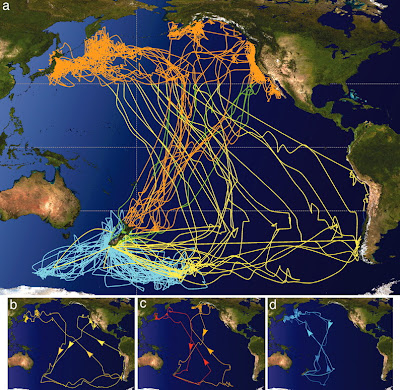
Streaked shearwater. Photo by Marj Kibby, at Flickr.
 Streaked shearwater at breeding colony on Mikura Island, Japan. Photo by Kanachoro, courtesy Wikimedia Commons.
Streaked shearwater at breeding colony on Mikura Island, Japan. Photo by Kanachoro, courtesy Wikimedia Commons.Most Streaked Shearwaters wintered off northern New Guinea, an area of low primary productivity but high Skipjack Tuna (Katsuwonus pelamis) abundance. Streaked Shearwaters flew for longer periods and landed on the water more frequently around dawn and dusk during the wintering period. This pattern of activity is similar to that of subsurface predators such as tuna, and to that of tropical seabirds that are known to feed with subsurface predators. We suggest that Streaked Shearwaters probably forage in association with subsurface predators in the tropical oceans during the wintering period. Foraging in association with subsurface predators and morphological adaptations for gliding may allow Streaked Shearwaters to forage efficiently in both temperate and tropical environments.
This Blue Planet video shows the dynamics of shearwaters (not sure which species) working schools of mackerel herded up to the surface, initially by dolphins, then by skipjacks.
 Sooty shearwaters. Photo by Marlin Harms, courtesy Wikimedia Commons.
Sooty shearwaters. Photo by Marlin Harms, courtesy Wikimedia Commons.
(Sooty shearwaters. Photo by marlin harms, courtesy Wikimedia Commons.) In an incredible piece of scientific detective work a few years back, a different team of researchers found that another species, sooty shearwaters (Puffinus griseus), embarked on remarkable 64,000-kilometer/40,000-mile annual migrations through the entire basin of the Pacific Ocean from Antarctica to the Bering Sea—the longest migration of any animal tracked to that point.
The map shows the geolocation tracks of 19 of their tagged sooty shearwaters at New Zealand breeding colonies (light blue); their migration pathways north (yellow); and their wintering grounds and southward transits (orange). Figures b–d represent the figure-eight movement patterns of individual shearwaters travelling to one of three “winter” destinations in the North Pacific. The authors suggest the figure-eight pattern is facilitated by prevailing wind patterns and by the Coriolis effect—which influence the long-range trajectories of the birds as they rocket between hemispheres at rates of up to 910 kilometers/565 miles a day, and as they chase the waves of summer from one hemisphere to the other.
 Credit: NASA/SeasatYou can correlate something of the travels of the sooty shearwaters to this map of prevailing winds over the Pacific. The 2006 sooty shearwater paper appeared in Proceedings of the National Academy of Sciences. From the abstract:
Credit: NASA/SeasatYou can correlate something of the travels of the sooty shearwaters to this map of prevailing winds over the Pacific. The 2006 sooty shearwater paper appeared in Proceedings of the National Academy of Sciences. From the abstract:
Electronic tracking tags have revolutionized our understanding of broad-scale movements and habitat use of highly mobile marine animals, but a large gap in our knowledge still remains for a wide range of small species. Here, we report the extraordinary transequatorial postbreeding migrations of a small seabird, the sooty shearwater, obtained with miniature archival tags that log data for estimating position, dive depth, and ambient temperature. Tracks (262 ± 23 days) reveal that shearwaters fly across the entire Pacific Ocean in a figure-eight pattern while traveling 64,037 ± 9,779 km roundtrip, the longest animal migration ever recorded electronically. Each shearwater made a prolonged stopover in one of three discrete regions off Japan, Alaska, or California before returning to New Zealand through a relatively narrow corridor in the central Pacific Ocean. Transit rates as high as 910 ± 186 km·day−1 were recorded, and shearwaters accessed prey resources in both the Northern and Southern Hemisphere’s most productive waters from the surface to 68.2 m depth.
But now the flying record of the sooty shearwaters been topped by a diminutive seabird, the Arctic tern, who not only crosses hemispheres but ocean basins as well. The February paper in PNAS for the first time revealed complete migrations for individual Arctic terns of more than 80,000 kilometers/48,000 miles a year.
 Arctic tern. Photo by Malene Thyssen, courtesy Wikimedia Commons.
Arctic tern. Photo by Malene Thyssen, courtesy Wikimedia Commons.
Such globe-trotting transits keep these butterflies-of-the-sea hopped up on the endless summers of the high-latitudes. They barely know night.
The papers:
- Takashi Yamamoto, et al. At-Sea Distribution and Behavior of Streaked Shearwaters (Calonectris leucomelas) During the Nonbreeding Period. The Auk. 2010. 127 (4) 871–881. DOI: 10.1525/auk.2010.1002.
- Akinori Takahashi. Post-breeding movement and activities of two Streaked Shearwaters in the north-western Paci?c. Ornithological Science. 2008. 7 (1) 29-35. DOI: 10.2326/osj.7.29.
- Scott A. Shaffer, et al. Migratory shearwaters integrate oceanic resources across the Pacific Ocean in an endless summer. PNAS. 2006. 103 ( 34) 12799-1280. DOI: 10.1073/pnas.0603715103.
- Carsten Egevang, et al. Tracking of Arctic terns Sterna paradisaea reveals longest animal migration. PNAS. 2010. 107 (5) 2078-2081. DOI: 10.1073/pnas.0909493107.
Crossposted from Deep Blue Home.






